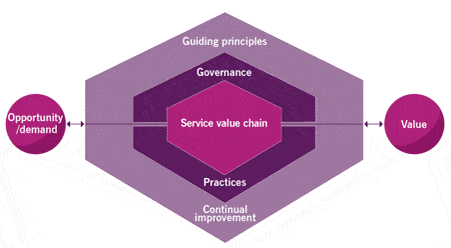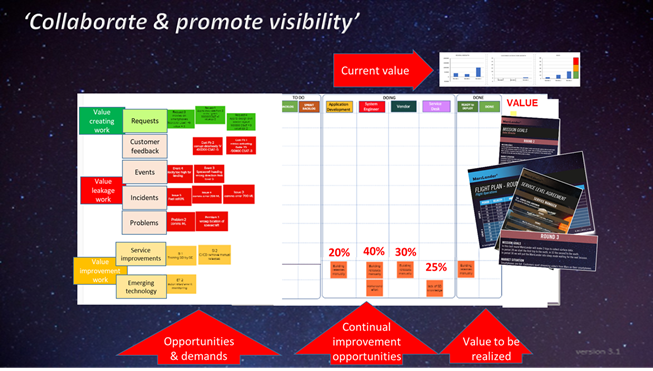Let’s talk about the value delivered via ITIL. As Mission Director in the MarsLander simulation, I’ve noticed some common characteristics that IT service management (ITSM) teams struggle with. Globally. Consistently. Worryingly. Dangerously. Teams usually come into the MarsLander simulation fresh from some ITIL 4 training, numbed by new concepts like Service Value System, Service Value Chain, Value Streams, and the ‘poster slogans’ contained within the Guiding Principles. Or they come into the simulation with baggage of ITIL from the past – with an operational focus. They cling onto their comfort blankets of processes – now practices – and tools. So how do we get the much-needed focus on the value delivered?
Gooey stuff
As Mission Director, I usually start by showing the team the ITIL Service Value System and then talk about the outside layer, more particularly about the ITIL Guiding Principles.

‘What have they got to do with ITIL? They’re just fluffy buzzwords and that gooey ‘cultural stuff.’ Just give us a fix of processes, practices, procedures, and some tooling. We know how to get this stuff working!’
‘….Yeah right! That’s what you all promised me as CEO with ITIL 2, 3, and 2011 plus now with ITIL 4! You may have achieved some success, but it’s time to raise the game!’
People need to know more about the value delivered.
The ITIL Guiding Principles
Why do I stress the importance of the ITIL Guiding Principles? Because the Guiding Principles help us to focus on desirable behaviors. After all, this is what, in my mind, we’re trying to achieve. We’re trying to create sustainable behaviors that deliver value, supported by practices and procedures and tools and stuff. And this is where we typically fail. As can be confirmed with the results of the ABC (Attitude, Behavior, Culture) workshops we’ve run in the last 15 years.
Focus on value
The number 1 top-scoring ABC card year-in, year-out is ‘IT has too little understanding of business impact and priority.’ This relates to the Guiding Principle ‘focus on value’ and is what is supposed to be popping out of the end of the Service Value Chain thingy in the middle of the Service Value System. And the stuff that should happen as a result of applying all those practices and things. The value delivered.
But what behaviors demonstrate a ‘focus on value’? This is one of the things we explore in MarsLander. ‘What is value?’ ‘Value to who?’ ‘What will we see people doing that shows a focus on the value delivered?’
‘Asking for the goals,’ ‘prioritizing work based on goals,’ ‘escalating when goals cannot be achieved,’ ‘notifying stakeholders about progress or delays,’ and ‘allocating resources accordingly’ perhaps. The team defines and agrees these behaviors themselves. Independently of the process, procedures, or tools. The focus is on the behaviors.
Collaborate and promote visibility (for value)
This understanding of what represents value needs to be transferred through the whole service value chain thing in the middle. This is where it all happens, at hand-offs and when decisions need to be made or priorities reshuffled. This is where ‘collaborate and promote visibility’ comes in. Again between simulation rounds, we ask ‘what does effective collaboration look like?’ We often hear things like ‘we share the goals, we communicate effectively, we escalate, we help each other, we listen to each other, we trust each other.’ Once again, the team defines these behaviors.
‘Is this the way you’d like to work together as an end-to-end team? Not just in this exercise, but in reality?’ I ask as Mission Director. ‘ Yes’ replies the team.
Value delivered: Start where you are
We then play the simulation, and everybody immediately ignores the list of desired behaviors.
(‘We don’t do fluffy stuff; we do practices and processes and get things done.’)
Nobody seems to own the behaviors, there’s no feedback, no coaching or correcting of behaviors, and usually, nobody knows the goals, nor understands the business risks.
The team has a visualization ‘tool’ that they’ve been given, but there’s no ownership for the end-to-end information needs. There’s no visibility into who is working on what. Everybody works in SILOS trying to achieve their own goals and complete their own work.
The result is that there’s no value delivered.
‘Just like reality’ declares many delegates.
Exactly. This is what we want to confront. We want to make ‘undesirable behaviors’ visible. Start where you are. Create a shared understanding of improvement needs. This is, by the way, that continual improvement ring on the outside of the Service Value System. Something that needs to be a core capability.
Collaborate and promote visibility (for value)
We know the theory of what we should be doing. But putting it into practice isn’t so easy. It also seems that there’s a difference between collaborating, which means ‘To work together with somebody to achieve a single shared goal’ and cooperation, which means ‘Work with other people by achieving one’s own goals as part of a common goal.’
We’re good at cooperating when it suits our goals (and KPIs), but collaborating is something else. As was revealed in an HBR article titled, “There’s a difference between cooperation and collaboration,” it was argued “… managers mistake cooperativeness for being collaborative,” adding, “… most managers are cooperative, friendly, willing to share information – but lack the ability and flexibility to align their goals and resources with others in real-time.”
If managers don’t get it, then what chance do the teams have when told – “You must collaborate”!
Focus on value (again) – the value delivered
The article also reveals ‘….It, more importantly, involves making tough decisions and trade-offs about what and what not to do, to adjust workloads across areas with different priorities and bosses. And despite all the well-meaning cooperative behaviors, this is often where interdepartmental collaboration breaks down…’ Which brings us again back to ‘Focus on value’ and a new element in the Service Value System model ‘Governance.’
This is where the ‘co-creation’ of value now starts hurting. Not all value can be realized. Somebody somewhere is NOT going to get the value delivered they were expecting. This needs to be a conscious decision. This requires visibility and stakeholder engagement.
Value delivered: Progress iteratively with feedback
Between game rounds, we look at what went well and what needs improving.
‘Collaborate and promote visibility?’ We’ve already seen we did not embed collaborative behaviors and ‘promote visibility’ means ‘visibility into work that needs doing,’ ‘visibility into work being done – or not,’ ‘visibility into shared goals vs. visibility into team or siloed goals.’ Plus, ‘visibility into what constitutes value’ – remember ‘Focus on value’? ‘Visibility to ensure we’re collaborating’ (end-to-end resources working on shared goals), ’visibility to give situational awareness,’ ‘visibility to enable fast, effective decision making’ – ‘focused on value’ and some kind of governance mechanism to help prioritize when conflicting value demands are competing for the same resources.
The team also learns that communication and collaboration go hand-in-hand. New behaviors are discovered such as ‘active listening,’ ‘giving feedback,’ ‘agreeing decision making authorities (governance),’ ‘agreeing information needs up-stream and down-stream’ to gain situational awareness, support and enable doing the work, and in making decisions.
Communication is also about the ‘information’ that needs to flow through the value streams, such as clear prioritization as work is handed off to ensure an end-to-end ‘Focus on value.’
Communication also means the need to avoid techno-speak and terms like features, incidents, problems, RFCs, and events when engaging with business stakeholders. If we’re expecting them to make informed decisions to prioritize workloads, then we need to talk more in business terms. Business outcomes, business risk – ‘Focus on value’ from the business perspective. This is often a huge change in mindsets and behaviors and demands a better business understanding within ITSM.
Teams quickly realize that if communication, collaboration, and visibility aren’t enabled, then mistakes are made. The ‘flow’ of work through the value streams stops or goes back upstream to get missing information or request rework, or is escalated upwards for decision making – ping-ponging back and forth and up and down like a pinball machine. So much for ‘High velocity IT’!
This is all very recognizable. Things never work as the team first implicitly assumed or agreed. Adopting new ways of working always seems to be about experimenting, gaining feedback, and making improvements. Improvements that the team can take on board (in terms of time allocated for improvements, and in terms of the maturity of the team and their ability to improve) – but not all teams are at the same maturity. It becomes clear that ‘Progress iteratively with feedback’ is a core set of skills and behaviors and that coaching is a key enabler.
Value delivered: Optimize and automate
Now that the teams are aware of the need to ‘Focus on value,’ to ‘Collaborate and promote visibility,’ and the importance of ‘Progressing iteratively with feedback’ they get a better idea of the demands they need to place on ‘Optimize and automate.’ Particularly how they can use ITSM tooling to support these new desirable behaviors. (I won’t go into automating tasks in this article).
The tool the team was given at the start of the exercise was an example of ‘A fool with a tool, is still a fool.’ They’d not been part of the tool design. They didn’t know how it should enable their work and enable the management and the value delivered. It’d been ‘thrown over the wall to them to use.’
The team explores, using a visual management board, how they can gain situational awareness – what information do they need to visualize to understand the business value delivered, to be able to prioritize work, to enable fast, effective decision making, to enable the smooth flow of work and hand-offs, to minimize risks, to allocate scarce resources appropriately, to reduce work in progress, and to identify waste and improvement opportunities?

Value delivered: Keep it simple and practical
They define their needs and design a new visualization capability. In the simulation, they do this on a board. (This in reality is what can then be engineered into an end-to-end ITSM tool suite). We design this with ‘Keep it simple and practical’ in mind. Often tools are engineered to complexity. The team needs to identify nice-to-have vs. need-to-have information to enable them to manage the flow of demands and opportunities through to the value delivered.
Value
- Visualize business goals (and executive-level metrics needed) to help focus on which demands and opportunities to prioritize.
- Rank work based upon value expectations or risk to business operations.
- Value realized as a result of work deployed through the value streams or value leakage caused by work not being done (lost opportunity) or due to downtime and rework.
- Impact of open improvement items (impediments) that are causing rework, incidents, or loss of value (e.g. customer satisfaction, costs of outages, costs of delay).
Demands and opportunities
- Provide oversight on the backlog of ‘value creation’ demands and opportunities in relation to the goals, also insight into the value delivered by the work.
- Oversight on the backlog of ‘value leakage’ work such as problems, incidents, and technical debt as well as the impact on value and the business risks. The risks now, and over time, to be able to review and reschedule priorities.
- Rework and incidents resulting from failed deployments and the impact on value and KPIs.
- Insight into ‘value improvement’ work to improve the value stream capabilities and to avoid future defects and rework.
Governance
- Clear view on prioritization and what the team needs to work on to maximize the value delivered through the value streams.
- Insight into the SLA to help prioritize work and identify SLA breaches.
- Understanding of, and insight into, business-critical moments and functionality to understand risks associated with problems, incidents, events, and the impact on the business value delivered.
Value chain
- Ability to identify resource constraints and workloads to improve the productivity of the team. Looking to see who is working on what. What issues are being worked on or are open, what work is not being done, which work may breach the SLA, skills shortages, and the impact on CSAT.
- Insight into the status of work in a value stream and where work has stopped flowing. To identify possible conflicts in prioritization, resource constraints, ineffective decision making or constraints, and improvement opportunities.
- Transparency for the customer team to see what is being worked on and the status of their requests and feedback.
- Agreeing with the stakeholders their information needs to be able to manage their work and make decisions.
- The need to ensure real-time accuracy of the visualization as work passes through the value stream to give situational awareness and improve faster decision-making capabilities. Making sure the right information is made available on the visualization board.
Continual Improvement
- Visualize improvement needs and ideas, track improvements that have been carried out and are delivering results, and improvements that still need working on to support and enable ‘progress iteratively with feedback.’
Value delivered: Think and work holistically
This is why I showed the Service Value System at the start of this article – to give a high-level overview of how the system fits together, and how it all needs to work in an integrated way, requiring end-to-end visibility of how demand is captured and translated into outcomes. In a complex system, the alteration of one element can impact others and, where possible, these impacts need to be identified, analyzed, and planned for. This is why situational awareness is critical to enable effective decision making.
Simulation ITSM tool discoveries
When the team applies the desired behaviors around collaboration, promoting visibility, and focus on value delivery, plus apply effective decision making and the behaviors to progress iteratively and capture and use the feedback they’re better able, from their role and responsibilities, to identify and agree on information needs that can be used to design their ITSM tool functionality.

At the end of the simulation, the team can see the visible improvement of the value delivered from their dashboard. Team satisfaction levels are high as work is flowing smoothly, they were able to make fast, effective decisions, and had clear insight into workloads, resource planning, and prioritization. They were also able to identify trends related to incidents and prioritize problem management activities to reduce risks.
Value delivered: Continual improvement
An interesting discovery was the dip in performance in Round 2. This is when the team invested in continual improvement to enable high-velocity capabilities and invested in resolving technical debt and high-risk problems. This meant accepting a short-term drop in performance (just like in reality, investing resources to scale up and enable high-velocity IT will take resources away from business as usual activities).
Then this resulted in significantly increased revenue growth and customer satisfaction in Round 3. This had been a conscious decision agreed by the business and IT team – an example of ‘co-creating’ value, and another reason why continual improvement is on the outside of the Service Value System. If you want to be able to take on more opportunities and demands, and optimize the value coming out, then you need to invest in continual improvement. And it needs to feed into strategic decision making. As stated in the ITIL 4 Foundation guidance “The Governing body should also have visibility of the outcomes of continual improvement activities and the measurement of value for the organization.”
Value delivered: The transfer of learning
At the end of the simulation, teams capture improvement actions to take away and apply. Did it make a difference?
“We are seriously bringing the learning points to life… The day we spent with you was a game-changer for us genuinely… The concepts of co-ownership, alignment, and value creation/value delivery/value leakage/value improvement have gained real traction on the ground and we are seeing sizeable benefits from that alone…’
My recommended actions for you based on this learning:
- Pin up the Service Value System diagram and ask people ‘What is the most important word?’ Tell them that it is value and then ask them ‘What does value look like to YOU?’ This will allow you to gain a perspective of value from different stakeholder perspectives.
- Pin up the Guiding Principles ‘Focus on value,’ ‘Collaborate and promote visibility,’ and ‘Progress iteratively with feedback’ on the walls of team rooms (product team, service team, and support team) and ask ‘What behaviors will we see that represent these principles?’ Then practice, feedback, improve, and repeat – because these behaviors need to become habits.
- Look at the list of visualization items clustered above in the ‘Keep it simple and practical’ section. Get end-to-end tool-related stakeholders together and ask, ‘Do we have the right situational awareness to make fast effective decisions and ensure that the end-to-end priorities relating to the value delivered can be managed?’ Start to discuss what upstream and downstream information is needed to enable the desired behaviors in step 2 and manage the value in step 1.
This will help to ensure engagement, dialog, and a better understanding of the value delivered. Plus, using these steps you ‘Progress iteratively with feedback’ as an example of ‘co-creating.’
If you liked this value delivered article, the following are also very popular with ITSM.tools readers:
- The Software Request Process – What Does Good Look Like?
- Service Desk Basics: What to Do When the End User Doesn’t Respond?
- Using ITIL 4 to Manage Risks
- ITIL Service Portfolio Management and Its Benefits Explained
- ITIL 4 Dummies
Or do you want to know about the ITIL 4 Service Desk?
Paul Wilkinson
Paul Wilkinson has been involved in the IT industry for more than 25 years and has a broad background in IT operations, IT management, and product innovation and development. He was project team lead in the original BITE (Business & IT Excellence) process modeling of ITIL, an ITIL V2 author, and member of the ITIL V3 advisory group.
He is co-owner of GamingWorks and co-developer of a range of business simulations focusing on IT service management, project management, business process management, business and IT alignment, alliance management and co-author and developer of the ABC of ICT products and publications.

